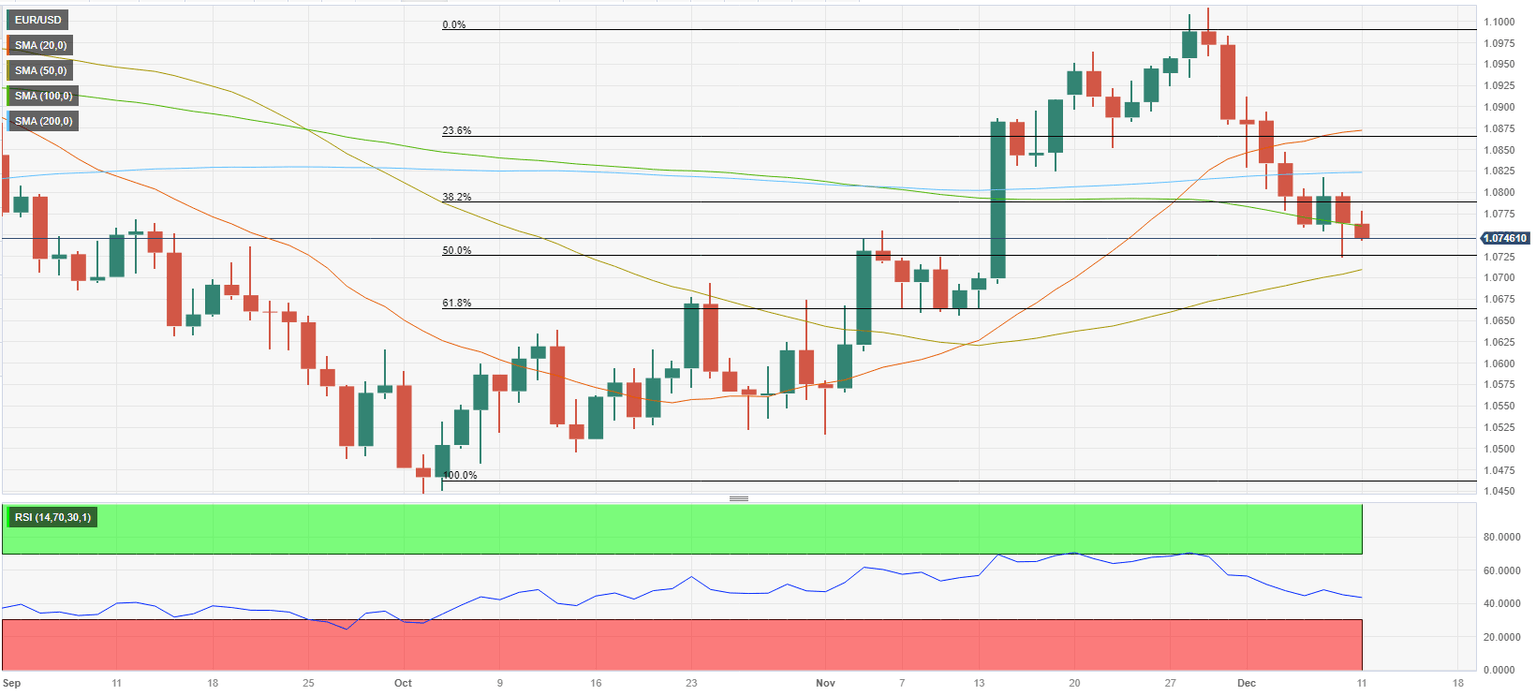Breaking: US CPI inflation softens to 3.1% as forecast

Inflation in the US, as measured by the change in the Consumer Price Index (CPI), declined to 3.1% on a yearly basis in November, the US Bureau of Labor Statistics (BLS) reported on Tuesday. This reading followed October's reading of 3.2% and came in line with the market expectation.
The annual Core CPI inflation, which excludes volatile food and energy prices, held steady at 4% as forecast. On a monthly basis, the CPI and the Core CPI rose 0.1% and 0.3%, respectively.
Follow our live coverage of the US inflation data and the market reaction.
"The index for shelter continued to rise in November, offsetting a decline in the gasoline index," the BLS said in its press release. "The energy index fell 2.3% over the month as a 6.0% decline in the gasoline index more than offset increases in other energy component indexes."
Market reaction to US inflation data
The US Dollar (USD) struggles to find demand after inflation figures. As of writing, the USD Index, which tracks the USD's performance against a basket of six major currencies, was down 0.4% on the day at 103.65.
US Dollar price today
The table below shows the percentage change of US Dollar (USD) against listed major currencies today. US Dollar was the weakest against the Japanese Yen.
| USD | EUR | GBP | CAD | AUD | JPY | NZD | CHF | |
| USD | -0.33% | -0.26% | -0.12% | -0.28% | -0.48% | -0.31% | -0.38% | |
| EUR | 0.33% | 0.09% | 0.22% | 0.03% | -0.20% | 0.01% | -0.06% | |
| GBP | 0.24% | -0.08% | 0.13% | -0.03% | -0.26% | -0.06% | -0.15% | |
| CAD | 0.11% | -0.21% | -0.15% | -0.14% | -0.37% | -0.20% | -0.27% | |
| AUD | 0.28% | -0.04% | 0.03% | 0.17% | -0.21% | -0.03% | -0.12% | |
| JPY | 0.48% | 0.17% | 0.24% | 0.36% | 0.24% | 0.21% | 0.12% | |
| NZD | 0.30% | -0.01% | 0.06% | 0.19% | 0.03% | -0.18% | -0.08% | |
| CHF | 0.38% | 0.07% | 0.15% | 0.28% | 0.11% | -0.13% | 0.08% |
The heat map shows percentage changes of major currencies against each other. The base currency is picked from the left column, while the quote currency is picked from the top row. For example, if you pick the Euro from the left column and move along the horizontal line to the Japanese Yen, the percentage change displayed in the box will represent EUR (base)/JPY (quote).
Economic Indicator
United States Consumer Price Index (YoY)
Inflationary or deflationary tendencies are measured by periodically summing the prices of a basket of representative goods and services and presenting the data as The Consumer Price Index (CPI). CPI data is compiled on a monthly basis and released by the US Department of Labor Statistics. The YoY reading compares the prices of goods in the reference month to the same month a year earlier.The CPI is a key indicator to measure inflation and changes in purchasing trends. Generally speaking, a high reading is seen as bullish for the US Dollar (USD), while a low reading is seen as bearish.
Read more.Why it matters to traders
The US Federal Reserve has a dual mandate of maintaining price stability and maximum employment. According to such mandate, inflation should be at around 2% YoY and has become the weakest pillar of the central bank’s directive ever since the world suffered a pandemic, which extends to these days. Price pressures keep rising amid supply-chain issues and bottlenecks, with the Consumer Price Index (CPI) hanging at multi-decade highs. The Fed has already taken measures to tame inflation and is expected to maintain an aggressive stance in the foreseeable future.
This section below was published at 03:00 GMT as a preview of the US November Consumer Price Index (CPI) data.
- The US Consumer Price Index is forecast to rise 3.1% YoY in November, down from the 3.2% increase recorded in October.
- Annual Core CPI inflation is expected to hold steady at 4% in November.
- US CPI inflation report could impact the US Dollar’s valuation ahead of the Fed’s policy announcements.
The highly-anticipated US Consumer Price Index (CPI) inflation data for November will be published by the Bureau of Labor Statistics (BLS) at 13:30 GMT. Inflation is expected to soften further, adding to the view that the Federal Reserve (Fed) is done hiking rates ahead of its last meeting of the year.
The US Dollar (USD) has stabilized in December after suffering large losses against its major rivals in November, with the USD Index falling nearly 3% on a monthly basis.
Although Fed officials remain committed to the data-dependent approach to monetary policy, the Fed is widely expected to leave the interest rate unchanged at the 5.25%-5.5% range after conducting the last monetary policy meeting of the year. The steady decline in inflation and growing signs of a cooldown in the labor market, however, caused markets to start anticipating a policy shift. According to the CME Group FedWatch Tool, there is a more than 40% probability of the Fed reducing the policy rate by 25 basis points as early as March.
US CPI inflation data could influence the market positioning regarding the timing of a policy shift and trigger a big reaction in the USD’s valuation before the Fed announces monetary policy decisions and releases the revised Summary of Economic Projections (SEP) on Wednesday.
What to expect in the next CPI data report?
The US Consumer Price Index, on a yearly basis, is expected to rise 3.1% in November, at a slightly softer pace than the 3.2% increase recorded in October. The Core CPI figure, which excludes volatile food and energy prices, is forecast to hold steady at 4% in the same period.
The monthly CPI and the Core CPI are seen rising 0.1% and 0.3%, respectively. Oil prices continued to decline in November, with the barrel of West Texas Intermediate falling another 7% after declining about 10% in October. Meanwhile, used car prices fell 2.1% in November, bringing the annual rate of fall to 5.8% in that period, according to the Manheim Used Vehicle Index.
Previewing the US November inflation report, “we look for core CPI inflation to rebound to 0.3% m/m from 0.2% in Oct, with the headline also strengthening to 0.1%,” said TD Securities analysts and explained:
“The report is likely to show that the core goods segment added to inflation, while the shelter components (OER/rents) are expected to remain mixed. Note that our unrounded core CPI inflation forecast at 0.29% m/m suggests largely balanced risks for November.”
In the meantime, the Prices Paid Index of the ISM Services PMI survey edged slightly lower to 58.3 in October from 58.6, while the Price Index of the Manufacturing PMI rose to 49.9 from 43.8. These readings showed that input price pressures in the service sector remained strong in November, while the deflation in the manufacturing input costs slowed down.
When will the Consumer Price Index report be released and how could it affect EUR/USD?
The Consumer Price Index inflation data for November will be published at 13:30 GMT. A monthly core inflation reading of 0.5% or higher could cause investors to refrain from betting on a policy shift in the first half of 2024 and provide a boost to the USD with the immediate reaction. On the other hand, a weak Core CPI increase of 0.2% or less could have the opposite impact on the USD’s valuation.
Investors could refrain from taking large positions based on the CPI data alone. On Wednesday, the Fed will release the revised Summary of Economic Projections, including the so-called dot plot, which could provide key clues regarding the timing of a policy shift.
Eren Sengezer, European Session Lead Analyst at FXStreet, offers a brief technical outlook for EUR/USD and explains:
“The near-term outlook for EUR/USD points to a lack of buyer interest. The pair, however, is yet to gather bearish momentum. The Relative Strength Index (RSI) indicator on the daily chart stays flat slightly below 50, while the pair was fluctuating near the 100-day Simple Moving Average (SMA) at the time of press, currently located at around 1.0750.”
“Nevertheless, EUR/USD needs to climb above 1.0820 (200-day SMA) and confirm that level as support to attract technical buyers. In this scenario, 1.0870 (Fibonacci 23.6% retracement of the latest uptrend) could act as interim resistance ahead of 1.1000 (psychological level, end-point of the latest uptrend). On the downside, the 1.0700–1.0720 area (Fibonacci 50% retracement, 50-day SMA) aligns as first support before 1.0650 (Fibonacci 61.8% retracement) and 1.0600 (psychological level, static level.)”
Inflation FAQs
What is inflation?
Inflation measures the rise in the price of a representative basket of goods and services. Headline inflation is usually expressed as a percentage change on a month-on-month (MoM) and year-on-year (YoY) basis. Core inflation excludes more volatile elements such as food and fuel which can fluctuate because of geopolitical and seasonal factors. Core inflation is the figure economists focus on and is the level targeted by central banks, which are mandated to keep inflation at a manageable level, usually around 2%.
What is the Consumer Price Index (CPI)?
The Consumer Price Index (CPI) measures the change in prices of a basket of goods and services over a period of time. It is usually expressed as a percentage change on a month-on-month (MoM) and year-on-year (YoY) basis. Core CPI is the figure targeted by central banks as it excludes volatile food and fuel inputs. When Core CPI rises above 2% it usually results in higher interest rates and vice versa when it falls below 2%. Since higher interest rates are positive for a currency, higher inflation usually results in a stronger currency. The opposite is true when inflation falls.
What is the impact of inflation on foreign exchange?
Although it may seem counter-intuitive, high inflation in a country pushes up the value of its currency and vice versa for lower inflation. This is because the central bank will normally raise interest rates to combat the higher inflation, which attract more global capital inflows from investors looking for a lucrative place to park their money.
How does inflation influence the price of Gold?
Formerly, Gold was the asset investors turned to in times of high inflation because it preserved its value, and whilst investors will often still buy Gold for its safe-haven properties in times of extreme market turmoil, this is not the case most of the time. This is because when inflation is high, central banks will put up interest rates to combat it.
Higher interest rates are negative for Gold because they increase the opportunity-cost of holding Gold vis-a-vis an interest-bearing asset or placing the money in a cash deposit account. On the flipside, lower inflation tends to be positive for Gold as it brings interest rates down, making the bright metal a more viable investment alternative.
Author

FXStreet Team
FXStreet


















